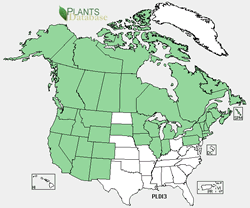Plant of the Week
 Platanthera dilatata range map. USDA PLANTS Database.
Platanthera dilatata range map. USDA PLANTS Database.
 Platanthera dilatata from Yakutat area, just north of Harlequin Lake Outlet, Alaska. Photo by Mary Stensvold.
Platanthera dilatata from Yakutat area, just north of Harlequin Lake Outlet, Alaska. Photo by Mary Stensvold.
 Platanthera dilatata from Glacier National Park, Montana. Photo by Peter Lesica.
Platanthera dilatata from Glacier National Park, Montana. Photo by Peter Lesica.
 Close-up of the flower stalk of Platanthera dilatata. Photo by Teresa Prendusi.
Close-up of the flower stalk of Platanthera dilatata. Photo by Teresa Prendusi.
White Bog Orchid (Platanthera dilatata)
By Walter Fertig
Some taxonomists estimate that there may be as many as 35,000 species in the orchid family worldwide, which would make it the largest family of vascular plants. Orchids are well known for their flamboyant colors, and often large and unusually shaped flowers with various slippers, hoods, buckets, or other floral contraptions designed to lure (and often trap) insect pollinators. Though most orchids occur in tropical latitudes, about 200 species are native to North America. Our indigenous orchids include many with showy and colorful flowers, such as fairy-slipper (Calypso), lady’s slipper (Cypripedium), grass-pink (Calopogon), and fringed orchid (Platanthera praeclara and relatives).
With 33 species, Platanthera is the largest genus of orchids found in North America. In the past, these species were placed in the largely Old World genus Habenaria along with several other species now classified in the genera Piperia and Coeloglossum. Commonly called bog, rein, or fringed orchids, members of the Habenaria-Platanthera group are all characterized by having a long, strap-like, or fringed lip petal that terminates at the back into a sac-like spur. When it develops in the bud, the lip is the uppermost of the three petals, but in all but one of our native species, the flower is strongly twisted at maturity (resupinate) so that the lip appears to be the lowest of the petals. Nectar-secreting glands that produce an aromatic, sugary reward to attract pollinators line the spur. The shape and length of the spur varies from species to species and is co-adapted to fit the tongue-length of pollinating moths or butterflies.
White bog orchid (P. dilatata) is a widespread species split into three varieties based on spur length and shape. In variety albiflora, the spur is club-shaped and shorter than the lip, while in var. dilatata the spur is more slender and equal in length to the lip. Variety leucostachys has strongly curved spurs that are more than 1.5 times longer than the lip. All of the varieties are similar in having numerous, small, white flowers clustered into a thick, elongated spike borne at the tip of leafy 6-36 inch tall stems. The lip petal is distinctive in being conspicuously broader at the base (“dilated”) than the smooth, tongue-shaped tip.
White bog orchid is primarily a denizen of wet places, including marshes, stream sides, springs, and bogs. The species has an unusual bipolar distribution pattern, with one population centered in northeastern North America from Manitoba to Newfoundland south to Illinois and Massachusetts, and a second ranging from Alaska to Alberta, Colorado, and California along the western cordillera. Only var. dilatata is present in eastern North America, while all three forms occur in the west.
In 2007, the number of Platanthera species in North America increased with the publication of a new species endemic to Yosemite National Park: P. yosemitensis. The species had first been documented (but not recognized as distinct) in 1923, but not relocated again for 80 years. Unlike white bog orchid, yellow flowers that emit a foul odor (described as resembling dirty feet or a horse corral on a hot day) characterize the new Yosemite species. If a new orchid can be found in one of our most-visited national parks, what other discoveries still beckon for the enterprising botanist?

